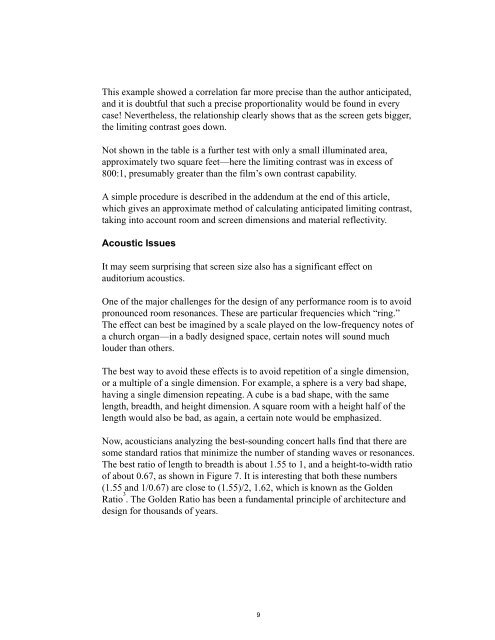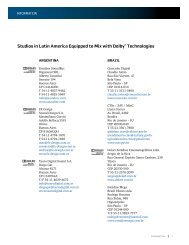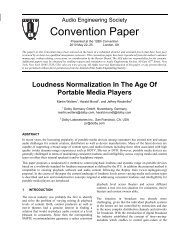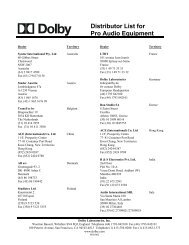Screen Sizes Impact on Picture and Sound - Dolby Laboratories Inc.
Screen Sizes Impact on Picture and Sound - Dolby Laboratories Inc.
Screen Sizes Impact on Picture and Sound - Dolby Laboratories Inc.
You also want an ePaper? Increase the reach of your titles
YUMPU automatically turns print PDFs into web optimized ePapers that Google loves.
This example showed a correlati<strong>on</strong> far more precise than the author anticipated,<br />
<strong>and</strong> it is doubtful that such a precise proporti<strong>on</strong>ality would be found in every<br />
case! Nevertheless, the relati<strong>on</strong>ship clearly shows that as the screen gets bigger,<br />
the limiting c<strong>on</strong>trast goes down.<br />
Not shown in the table is a further test with <strong>on</strong>ly a small illuminated area,<br />
approximately two square feet—here the limiting c<strong>on</strong>trast was in excess of<br />
800:1, presumably greater than the film’s own c<strong>on</strong>trast capability.<br />
A simple procedure is described in the addendum at the end of this article,<br />
which gives an approximate method of calculating anticipated limiting c<strong>on</strong>trast,<br />
taking into account room <strong>and</strong> screen dimensi<strong>on</strong>s <strong>and</strong> material reflectivity.<br />
Acoustic Issues<br />
It may seem surprising that screen size also has a significant effect <strong>on</strong><br />
auditorium acoustics.<br />
One of the major challenges for the design of any performance room is to avoid<br />
pr<strong>on</strong>ounced room res<strong>on</strong>ances. These are particular frequencies which “ring.”<br />
The effect can best be imagined by a scale played <strong>on</strong> the low-frequency notes of<br />
a church organ—in a badly designed space, certain notes will sound much<br />
louder than others.<br />
The best way to avoid these effects is to avoid repetiti<strong>on</strong> of a single dimensi<strong>on</strong>,<br />
or a multiple of a single dimensi<strong>on</strong>. For example, a sphere is a very bad shape,<br />
having a single dimensi<strong>on</strong> repeating. A cube is a bad shape, with the same<br />
length, breadth, <strong>and</strong> height dimensi<strong>on</strong>. A square room with a height half of the<br />
length would also be bad, as again, a certain note would be emphasized.<br />
Now, acousticians analyzing the best-sounding c<strong>on</strong>cert halls find that there are<br />
some st<strong>and</strong>ard ratios that minimize the number of st<strong>and</strong>ing waves or res<strong>on</strong>ances.<br />
The best ratio of length to breadth is about 1.55 to 1, <strong>and</strong> a height-to-width ratio<br />
of about 0.67, as shown in Figure 7. It is interesting that both these numbers<br />
(1.55 <strong>and</strong> 1/0.67) are close to (1.55)/2, 1.62, which is known as the Golden<br />
Ratio 3<br />
. The Golden Ratio has been a fundamental principle of architecture <strong>and</strong><br />
design for thous<strong>and</strong>s of years.<br />
9










